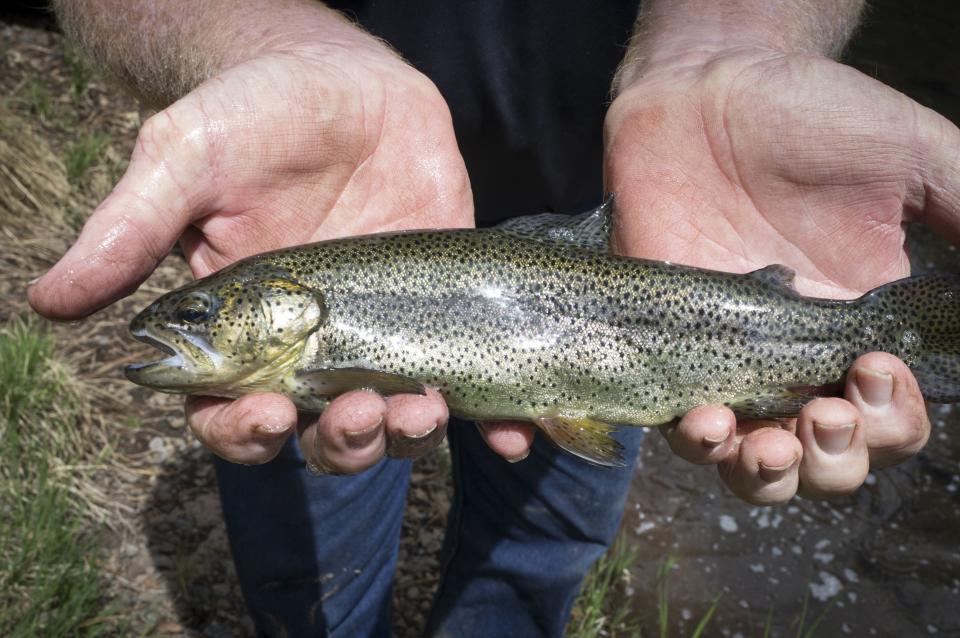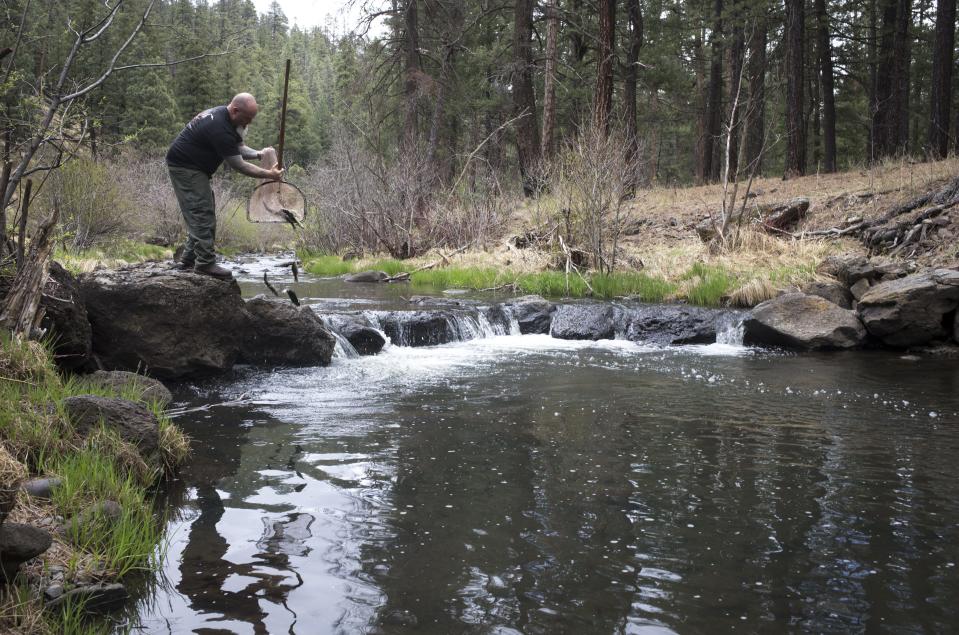Here's what to know about a proposal to remove the Apache trout from the threatened list
The U.S Fish and Wildlife Service is proposing to remove the Apache trout from the Endangered Species list, more than 50 years after it was first added.
The announcement comes a year after the agency announced the completion of a five-year review, which recommended desisting of the species after successful recovery efforts.
Habitat conservation, non-native trout removal and reintroduction of the species have all helped significantly increase populations and genetic diversity of the Apache trout, officials say.
“The Apache trout’s recovery is a significant conservation milestone and a remarkable story to celebrate, especially now during the 50th anniversary of the Endangered Species Act,” said Amy Lueders, Fish and Wildlife Service Regional Director. “The ESA makes a difference by bringing people together to find solutions to conserve and recover imperiled species like the Apache trout.”
If delisted, it would be the first game fish to be removed from the list of threatened and endangered species.
Why is the Apache trout so important?

The Apache trout is the state fish of Arizona.
It's native to the state and can only be found in streams in and near the White Mountains in eastern Arizona.
The Apache Trout has been a threatened or endangered species for nearly as long as it has been properly recognized. Formerly known as yellowbellies because of their distinct golden belly, the fish was originally considered the same species as the Gila trout, which was listed under the Endangered Species Preservation Act in 1967 and shares much of the same range as the fish.
But five years later it was found to be an entirely different species and gained official protection under the Endangered Species Act of 1973.
It was among one of the first species to be recognized as endangered under the Endangered Species Act, a measure the U.S Supreme Court at the time called, “the most comprehensive legislation for the preservation of endangered species enacted by any nation.”
The fish was subsequently downlisted to threatened in 1975, which allowed for recreational fishing, with restrictions.
Why was it listed?
More than a hundred years ago, the Apache trout was abundant in the White Mountains. The fish once occupied areas stretching more than 680 miles. That range has since been reduced to about 30 percent of the original territory.
The biggest threat to the Apache trout was the introduction of invasive species to the range. Other species of trout including, brook, brown, rainbow, and cutthroat, were added to bolster a shrinking food source caused by overfishing. Those fish began feeding on the smaller Apache trout, and crossbreeding with other species significantly reduced purebred populations of the endemic fish.
Overfishing, livestock grazing, increased temperatures and wildfire have all also been linked to a decline in population.
In 2011, the Wallow Fire swallowed more than half a million acres of forest in the White Mountains. It caused significant damage to the Fish Creek watershed, an area that, before the fire, had an adult population of over 1,000 trout, which is significant for a creek of its size. A monsoon storm following the fire wiped out the creek.
It was a major blow to recovery efforts.
Less canopy cover, caused by wildfire will also result in more direct sunlight and warm the streams. Since the fish is a cold-water species, warmer waterways is bad news. If streams reach a median temperature of 66 degrees Fahrenheit or above, the fish will experience reduced growth and their chance for survival drops significantly.
The effects of increased temperate, drought, and wildfire are still a major concern for the species. As a result, some argue the fish is not ready for delisting.
“There’s been good progress toward bringing Apache trout back from the brink of extinction, but it’s way too soon to strip protections for these remarkable fish,” said Robin Silver, of the Center for Biological Diversity. “Their habitat has been hammered by grazing and fires, and they won’t survive without the Endangered Species Act’s safeguards. Non-native trout and growing dangers from climate change also jeopardize the trout’s survival.”
Imperiled species: How an Arizona tribe and wildlife biologists rescued the Apache trout from near extinction
How did the fish bounce back?

Aware of the threats the fish faced, in 1955 the White Mountain Apache Tribe took the first steps to conserve the species by closing tribal lands to fishing in areas where pure trout population remained.
In essence, the tribe declared the fish endangered 18 years before the Endangered Species Act was enacted.
Once the fish was federally recognized as endangered in 1973, USFWS joined with the White Mountain Apache Tribe Game and Fish, as well as the U.S. Forest Service and Arizona Game and Fish Department. Watershed management plans were developed, and conservation efforts shifted toward segregating non-native trout and Apache trout.
The effort to restore the population included a halt to stocking non-native species in and near Apache trout habitats, construction of barriers to keep non-native trout out and removal of those that were already there.
“The Apache trout comeback is really a story about what can happen when passionate cooperators come together to take care of their home waters,” Trout unlimited, a partner in restoring populations of the fish said in a statement. “We’re proud to have played a role in these efforts in conjunction with our partners at the White Mountain Apache Tribe, Arizona Game and Fish Department, U.S. Forest Service and U.S. Fish and Wildlife Service, and look forward to continuing the restoration of Arizona’s state fish."
Today agencies are working to remove fish barriers that may seperate populations of the now more robust populations of Apache trout.
USFWS says removing outdated fish passage barriers will help reconnect fragmented habitat and Apache trout populations, increasing genetic diversity.
“There are 30 verified self-sustaining populations of pure Apache trout in the wild for the first time in decades, which can be credited to dedicated habitat management, introduction of captive bred fish, and collaborative conservation efforts by the U.S. Fish and Wildlife Service, White Mountain Apache Tribe, state of Arizona, and U.S. Forest Service” said Andrew Carter, of Defenders of Wildlife. “The ESA, again, proves to be one of our strongest tools to protect wildlife and wild places.”
The delisting proposal comes after a five-year review and 2021 species status assessment, using the latest scientific research and information. The assessment evaluated the species’ current needs, conditions, and threats, in addition to modeling future scenarios.
The most recent review, published last August, recommended delisting this species due to recovery.
What happens to the Apache trout next?
If the Apache trout is delisted, active management to maintain conservation barriers and limit hybridization with non-native trout species will continue, according to Fish and Wildlife Service.
The ESA also requires the service to implement a post-delisting monitoring plan for a minimum of five years to ensure the species remains stable.
Comments on the proposed delisting must be received within 60 days of its publication in the Federal Register. Information on how to submit comments can be found here, by searching under docket number FWS-R2-ES-2022-0115. Information on how to request a hearing is also included in the Federal Register notice.
Wildlife in danger: Jaguars, leopard frogs, condors: Here are some of Arizona's most imperiled species
Jake Frederico covers environment issues for The Arizona Republic and azcentral. Send tips or questions to jake.frederico@arizonarepublic.com.
Environmental coverage on azcentral.com and in The Arizona Republic is supported by a grant from the Nina Mason Pulliam Charitable Trust. Follow The Republic environmental reporting team at environment.azcentral.com and @azcenvironment on Facebook, X, formerly Twitter and Instagram.
You can support environmental journalism in Arizona by subscribing to azcentral today.
This article originally appeared on Arizona Republic: Feds propose delisting Arizona's Apache trout after recovery program

